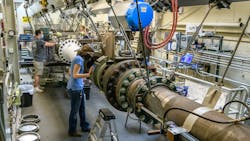Purdue University and the University of Notre Dame are teaming on research for the Air Force Research Laboratory (AFRL). The schools are combining extensive hypersonic research backgrounds to help develop the next generation of high-speed vehicles capable of flying at Mach 5 (five times the speed of sound) and beyond as part of a $5.8 million research program for AFRL. Both universities are home to separate Mach 6 quiet wind tunnels (see figure) as well as unique combustion facilities. Faculty researchers from both schools will explore the design of higher-speed flying vehicles though the use of experimentation, modeling, and simulation of such parameters as heat transfer and air flow.
Dan DeLaurentis, director of the Institute for Global Security and Defense Innovation (i-GSDI), said multidisciplinary teams are essential for the future of hypersonic research:
“Disciplines including aerodynamics, aerothermal effects and propulsion all can come into play when a vehicle is flying at hypersonic speeds,” he said. “Multidisciplinary research is a point of emphasis for the i-GSDI and the Department of Defense,” he added.
Jonathan Poggie, a Purdue professor of aeronautics and astronautics, will lead the hypersonic program. Poggie explained: “The role of our research is to provide support to military and NASA, providing them the research needed to make more accurate predictions about some of their toughest hypersonic problems. We will provide insight into extreme heat loads, aerodynamic forces and unpredictable control characteristics interacting with a vehicle when it flies at such high speeds.” Purdue features about 40 world-renowned researchers in hypersonic with expertise in navigation, aerodynamics, aerothermal effects, propulsion, autonomy, system engineering, high-temperature materials, and manufacturing.
About the Author
Jack Browne
Technical Contributor
Jack Browne, Technical Contributor, has worked in technical publishing for over 30 years. He managed the content and production of three technical journals while at the American Institute of Physics, including Medical Physics and the Journal of Vacuum Science & Technology. He has been a Publisher and Editor for Penton Media, started the firm’s Wireless Symposium & Exhibition trade show in 1993, and currently serves as Technical Contributor for that company's Microwaves & RF magazine. Browne, who holds a BS in Mathematics from City College of New York and BA degrees in English and Philosophy from Fordham University, is a member of the IEEE.
